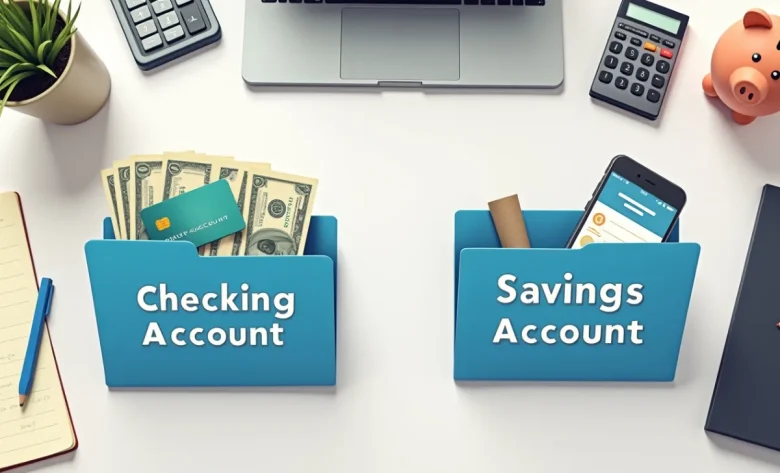A bank account is essential for managing your money safely and efficiently. Checking accounts and savings accounts are the two most common types of accounts. While they may seem similar, each has its own unique features and uses. Understanding the differences between the two can help people make better financial choices and use their money more effectively. Both accounts are secure, user-friendly, and easily accessible, but their uses are quite different.
What is a savings account?
A savings account is an account where your money is held securely and earns interest. It’s designed to encourage people to save instead of spending. When you deposit money into a savings account, the bank pays interest, meaning your money grows slowly over time. People typically don’t use savings accounts for day-to-day transactions. Instead, they use them to save for future needs, emergencies, or long-term goals. Many banks now limit the withdrawal amount from savings accounts to encourage saving instead of spending.
What is a checking account?
A checking account, also called a current account, is used for everyday financial transactions. You can deposit and withdraw money as often as you like, making it ideal for paying bills, receiving payments, and making everyday purchases. Checking accounts typically don’t offer the same high interest rates as savings accounts, but they do provide convenient access to money when you need it. Customers typically receive a debit card and checkbook linked to their checking account, making payments easier and faster.
Top Reasons to Open a Savings Account
The main reason people open a savings account is to save money and earn interest. It’s a safe place to keep emergency funds, long-term savings, or money for specific purposes, such as education or travel. Banks typically offer better interest rates on savings accounts than on checking accounts because they prefer saving to spending. This makes checking accounts ideal for people who want to keep their money safe while it grows.
Top Uses of a Checking Account
The main reason to open a checking account is to simplify everyday transactions. It’s a source of funds for bills, groceries, and other daily expenses. Typically, the money comes from your salary or other income sources. Checking accounts aren’t designed to grow your money through interest; they’re designed to help you track your income and expenses. Checking accounts are customizable, making money management quick and easy in today’s world.
Interest and Money Growth
One of the key differences between savings and checking accounts is how they handle interest. Most savings accounts pay interest, meaning the money you deposit grows over time. The interest may not be very high, but it still helps your money grow. In most cases, checking accounts don’t pay interest, and even if they do, it’s very little. Because of this difference, savings accounts are better suited for building wealth, while checking accounts are better for everyday expenses.
Security and Safety of Both Accounts
Saving money in both savings and checking accounts is safe. Customers can trust that banks have robust security procedures and that government initiatives generally protect their deposits. Savings accounts, on the other hand, are less susceptible to abuse because they are used less frequently. People frequently use checking accounts for transactions, necessitating careful monitoring to prevent fraud or overdrafts. Both accounts are safe, but the security objectives differ depending on how they are used.
Who Should Use a Savings Account
Anyone who wants to save for the future can open a savings account. Anyone saving for purposes such as buying a car, going to college, or building an emergency fund can benefit from a savings account. Savings accounts are also a beneficial option for people who want to protect their money and earn extra interest. Saving money and developing financial discipline are both good reasons to open a savings account.
Who Should Use a Checking Account
Anyone who needs regular access to money should open a checking account. Checking accounts are useful for people who receive a salary, businesses that need to pay bills and suppliers, and anyone who handles money daily. These days, a checking account is essential because it allows you to spend money as you wish. If you want a bank account that is simple to use and accessible, a checking account is the best choice.
Conclusion
You might think that savings accounts and checking accounts are the same, but that’s not true. Checking accounts are used for daily transactions and easy access, while savings accounts are used to store money and earn interest. In today’s financial world, both accounts are safe and important, but they are used differently. Having one or both accounts allows people to manage their money rationally, track daily expenses, and save for the future. The first step to effective financial management is understanding the difference between the two.
FAQs
1. What are the main differences between checking and savings accounts?
Checking accounts are used for daily transactions and easy access, while savings accounts are used to store money and earn interest.
2. Can I have both a savings and a checking account?
Yes, many people use both accounts to better manage their money by separating daily expenses from long-term investments.
3. Do checking accounts earn interest?
Most checking accounts don’t earn interest, or the interest rate is very low compared to savings accounts.
4. Are there withdrawal limits for savings accounts?
Yes, many banks limit the number of withdrawals you can make per month from your savings account to encourage you to save more.
5. Which account is best for daily use?
A checking account is better for daily use because you can make transactions, use a debit card, and pay bills with it.




